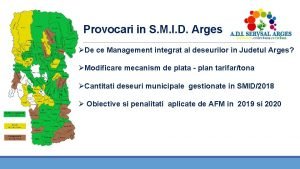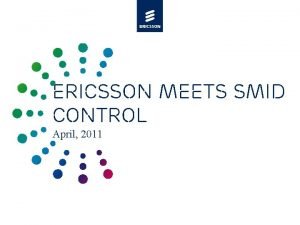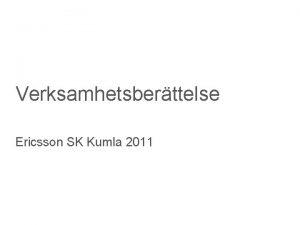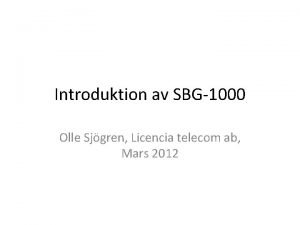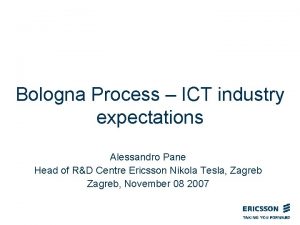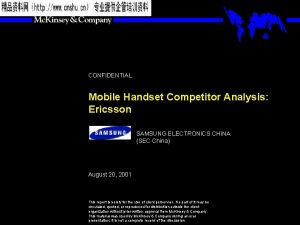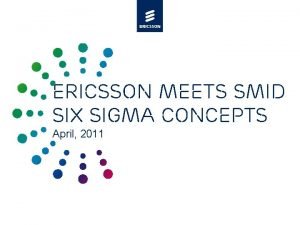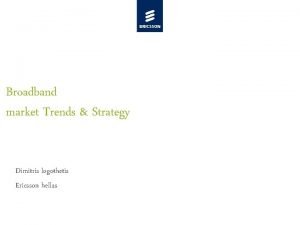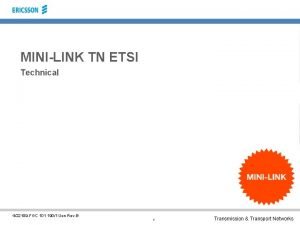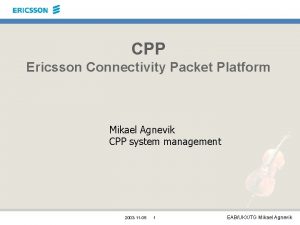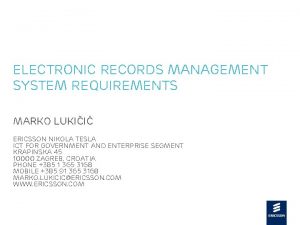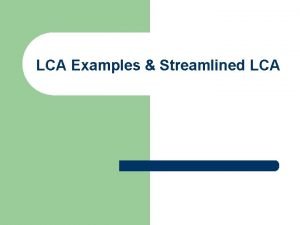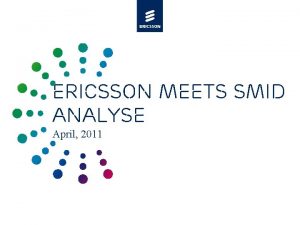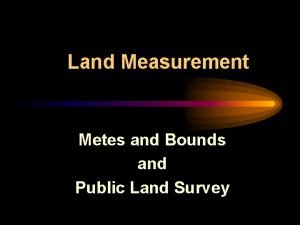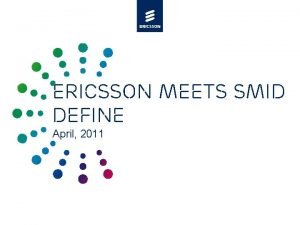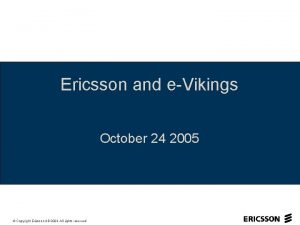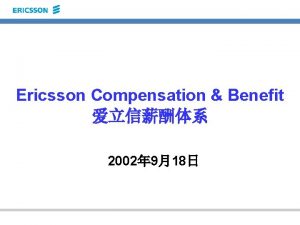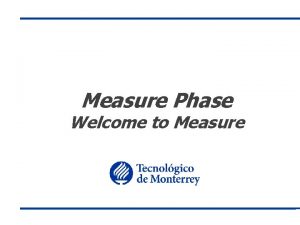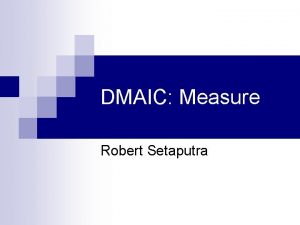Ericsson meets SMID measure April 2011 Agenda 4
















































- Slides: 48

Ericsson meets SMID measure April, 2011

Agenda › 4 th April – Ericsson presentation – Statistical tools in manufacturing – DMAIC/IDDOV › 7 th April – Define – Measure › 11 th April – Analyze › 14 th April – Implement – Control Ericsson @ SMID - Measure phase | Commercial in confidence | © Ericsson AB 2011 | 2011 -03 -24 | Page 2

DMAIC Chart Comprehensive Light D efine M easure A nalyze I mprove C ontrol Understand the task and its financial impact. Develop and execute an appropriate data collection method. Find the root causes. Generate and implement solutions. Ensure that the results will last. • Task selection matrix • SMART review • Stakeholder map • Risk Management • Process map • Data collection table • Pareto diagram • Fishbone diagram • Correlation analysis • FMEA risk analysis • Process map • Documentation, standardization and training • SWOT analysis • Process map • VOC and break down to CTQs • 7 MT • Affinity diagram • 7 QCT • 7 MT • Measurement system analysis • Sampling technique • SIPOC • Gauge R&R, Gauge attribute • Capability analysis • Benchmark • Tagushi loss functions • 7 QCT • Hypothesis testing • Regressionanalysis • DOE • Anova • 7 MT • Data transformations • Simulations • Poka-Yoke • Hypothesis testing • Loss functions • Cost/Benefit selection • Pugh Concept Selection • 7 QCT • SPC • Business case verification Ericsson @ SMID - Measure phase | Commercial in confidence | © Ericsson AB 2011 | 2011 -03 -24 | Page 3

7 MT Seven Management Tools

7 Management Tools Which tool to choose? ? ? Affinity diagram ”WHAT” Flowchart ”IF-OTHERWISE” Relation diagram ”WHY” Tree diagram ”HOW” Arrow diagram Matrix diagram ”WHEN” ”WHICH ONE” Ericsson @ SMID - Measure phase | Commercial in confidence | © Ericsson AB 2011 | 2011 -03 -24 | Page 5 Fishbone diagram ”CLARIFY”

Variation is our business enemy number one. Ericsson @ SMID - Measure phase | Commercial in confidence | © Ericsson AB 2011 | 2011 -03 -24 | Page 6

The Statistical Objective of Six Sigma Process Off Target Excessive Variability Target Reduce variation Defects Process Off Target Center Process Target LSL USL Defects Target LSL USL LSL Ericsson @ SMID - Measure phase | Commercial in confidence | © Ericsson AB 2011 | 2011 -03 -24 | Page 7 USL

Graphical analysis För länge sen fanns det en kung och en drottning, som varje dag sa till varann: -Tänk, om vi ändå hade haft ett barn! Men de hade ingen fått. Så en dag, när drottningen badade, hände sig att en groda kröp upp ur vattnet och sa till henne: - Din längtan blir uppfylld. Inom ett år, kommer du att få en dotter. Precis som grodan hade sagt, gick det. Drottningen fick en dotter, som var så fager att kungen blev utom sig av glädje och ställde till med en stor fest. Han bjöd inte bara sina släktingar, vänner och bekanta utan också feerna, för att de skulle bli goda och nådiga mot barnet. Det fanns tretton feer i hans rike. Men hade bara tolv guldtallrikar som de kunde äta på; därför fick den trettonde stanna hemma. Festen firades med pompa och ståt, och när den var över, skänktefererna åt prinsessan underbara gåvor. Den ena gav henne dygd, den andra skönhet, den tredje rikedom och så vidare. Den lilla prinsessan fick allt som man kunde önska sig här i världen. När elva av feerna hade meddelat sina goda önskningar, kom plötsligt den trettonde in. Hon ville hämnas för att hon inte hade blivit bjuden, och utan att hälsa eller ens se på någon, ropade hon med hög röst: - Kungadottern komer att sticka sig på en slända, när hon blir femton år, och hon kommer att falla död ner. Utan ett ord mer vände hon om och lämnade salen. Alla blev förskräckta. Då trädde den tolfte feen fram, hon som ännu inte hade meddelat sin önskan. Eftersom hon inte kunde utplåna den onda spådomen utan bara mildra den, så sa hon: Prinsessan kommer inte att dö utan bara sova djupt i hundra år. Kungen ville bevara sitt älskade barn och därför skickade han ut en befallning att alla sländor i hela riket skulle eldas upp. Men feernas önskningar passade helt in på flickan. Hon blev fager och god, vänlig och klok och alla som såg henne älskade henne. Den dan hon fyllde femton år, var kungen och drottningen inte hemma, och flickan var ensam i slottet. Där strövade hon omkring överallt, kikade in i salar och kammare, som det föll henne in och till sist kom hon till ett gammalt torn. En smal spiraltrappa förde upp till en liten dörr. I låset satt en rostig nyckel. När flickan vred om, öppnade dörren sig, och i den lilla kammaren innanför satt en gammal gumma vid en slända och spann flitigt lin. - God dag, gamla mor, sa prinsesan, vad gör du? - Jag spinner, svarade gumman och nickade med huvudet. - Vad är det som snurrar och surrar så lustigt? frågade flickan och hon tog sländan och ville spinna, hon med. Men knappt hade hon rört spinnstolen, förrän spådomen gick iuppfyllellse och hon stack sig i fingret på sländan. I samma ögonblick som hon stack sig, sjönk hon ner på bädden, som stod där, och föll i djup sömn. Och hela slottet föll i sömn på samma gång som hon. Kungen och drottningen som just hade kommit hem och kommit in i salen, somnade, och hela hovet med dem. Hästarna i stallet, hundarna på gården, duvorna på taket, flugorna på väggen, alla sov. Ja, till och med elden, som flammade i spisen, blev stilla och somnade in. Steken slutade fräsa, och kocken som just skulle ge kökspojken en örfil, träffade honom inte och båda somnade. Vinden la sig och träden utanför slottet slutade susa. Runt omkring sottet växte en törnroshäck upp. För varje år blev den allt högre, ochtlll sist omgav den hela sottet och växte höre än tornen, så att inte ens flaggorna syntes. I riket berättade man sagan om den sköna sovande Törnrosa - så kallades nämligen prinsessan - och ibland kom prinsar och unga riddare som ville tränga igenom häcken för att komma in i slottet. Men det var omöjligt, för törnet höll tätt och flera ynglingar blev hängande där utan att kunna komma loss och de dog en jämmerlig död. Efter många och långa år kom slutligen en prins till riket och han hörde en gammal man berätta om törnroshäcken. Innanför den låg ett slott, sa gubben, där en underbar prinsessa sov sedan hundra år, och med henne kungen, drottningen och hela hovet. Gubben hade också hört sin farfar säga, att många prinsar hade kommit dit och försökt tränga genom häcken, men de hade fastnat och dött en sorglig död. Då sa ynglingen: -Jag är inte rädd, jag vill rida dit och se den fagra Törnrosa. Och hur ivrigt den gamle än avrådde honom, ville prinsen inte lyssna till hans ord. u hade faktiskt de hundra åren just gått, och den dagen var kommen, när Törnrosa skulle vakna upp igen. När kungasonen nalkades häcken, bestod den av idel stora, vackra rosor. De böjde sig undan av sig själva och släppte igenom honom helt oskadd. Bakom honom slöt de sig åter till en häck. å slottsgården såg han hästarna och de brokiga jakthundarna ligga och sova; på taket satt duvorna med huvudet under vingen. När han kom in i slottet, sov flugorna på väggen, kocken i köket höll fortfarande handen lyft över kökspojken, och pigan satt med den svarta tuppen som skulle plockas. är prinsen fortsatte, såg han hela slottet ligga sovande i den stora salen, och på tronen slumrade kungen och drottningen. Han gick vidare och allt var så tyst att varje andedrag hördes. Slutligen kom han till tornet och öppnade dörren till den lilla kammaren, där Törnrosa låg och sov. är låg hon och var så vacker, att han inte kunde ta blicken ifrån henne. Han böjde sig ner och gav henne en kyss. Så snart hans mun hade rört vid flickans mun, slog hon upp ögonen, vaknade och såg vänligt på honom. Sen gick de ut tillsammans, och kungen, drottningen och hela hovet vaknade, och alla såg på varandra med stora ögon. Hästarna på gården reste sig, jakthundarna hoppade och viftade med svansarna, duvorna på taket drog huvudet ur vingen och såg sig om och flög ut över fälten. Flugorna på väggen kröp vidare, elden i köket tog fart; steken började fräsa, kocken gav kökspojken en örfil, så att han skrek, och pigan plockade tuppen färdig. Så firade prinsen och Törnrosa bröllop med prakt och ståt, och sen levde de lyckliga i alla sina dagar. A picture says more than a thousand words! Ericsson @ SMID - Measure phase | Commercial in confidence | © Ericsson AB 2011 | 2011 -03 -24 | Page 8

Why we use graphical analysis? Graphical tools are some of the most powerful (and simplest to apply) in the Six Sigma Toolbox They are always the starting point for understanding your data Ericsson @ SMID - Measure phase | Commercial in confidence | © Ericsson AB 2011 | 2011 -03 -24 | Page 9

Graphical analysis – Easier to understand › Children's books contains pictures and very little words › Children learn by figures “These have a relation” › People use words to explain…. …. . But if words is not enough a picture is added › The human eye can see more than an artificial test Ericsson @ SMID - Measure phase | Commercial in confidence | © Ericsson AB 2011 | 2011 -03 -24 | Page 10

Common tools › › › › Pie charts Time series plots Histogram Process capability plots Box plot Scatter plot Matrix Plot Ericsson @ SMID - Measure phase | Commercial in confidence | © Ericsson AB 2011 | 2011 -03 -24 | Page 11

Pie Charts „Reasons for late approval“ (percentage) Ericsson @ SMID - Measure phase | Commercial in confidence | © Ericsson AB 2011 | 2011 -03 -24 | Page 12

Time Series Plot The time series plot is a useful diagnostic tool. Often these plots will show a story – trends, sudden shifts, a regular cycle, extreme values… all can be used as leads in the problem solving process. Ericsson @ SMID - Measure phase | Commercial in confidence | © Ericsson AB 2011 | 2011 -03 -24 | Page 13

Frequency Diagrams - Histogram The Histogram is used to look graphically at the distribution of data The source data is sub-divided into categories, eg. 60 -55, 55 -60, …, and the frequency of occurrence is plotted for these, giving a graph similar to below. The type of distribution can be estimated from this, as can the mean, median & mode Ericsson @ SMID - Measure phase | Commercial in confidence | © Ericsson AB 2011 | 2011 -03 -24 | Page 14

Detecting trends 60 10 50 Frequency 40 5 30 20 0 10 10 15 20 25 30 35 40 45 50 55 The same data plotted in two different ways…. The trend is obvious. Without the TS plot in this case the data, wrong conclusions would hade been drawn with the base of the data Ericsson @ SMID - Measure phase | Commercial in confidence | © Ericsson AB 2011 | 2011 -03 -24 | Page 15

Capability analysis describes the process performance Ericsson @ SMID - Measure phase | Commercial in confidence | © Ericsson AB 2011 | 2011 -03 -24 | Page 16

The Box Plot is useful for comparing distributions. The box represents the middle 50% of the distribution. The horizontal line is the median. Asterisks represent points which would fall outside the expected range of values. Ericsson @ SMID - Measure phase | Commercial in confidence | © Ericsson AB 2011 | 2011 -03 -24 | Page 17

Scatter Plot The Scatter plot is a useful tool in understanding the relationship between two variables. One variable is plotted on the X-axis and the other on the Y-axis, giving a graph as below. This example indicates that test point 1 correlates with test point 2. Further tools could be used to prove or disprove this. Ericsson @ SMID - Measure phase | Commercial in confidence | © Ericsson AB 2011 | 2011 -03 -24 | Page 18

Matrix plot The Matrix plot is a useful tool quick check up many relations. Ericsson @ SMID - Measure phase | Commercial in confidence | © Ericsson AB 2011 | 2011 -03 -24 | Page 19

Common Shapes Of Frequency Diagrams Observe Conclude Action Use capability analysis Symmetric, bell-shaped If chart shows no special causes, data may come from a stable process. Bi-modal, two humps Data may come from a mixture of two processes. Asymmetric, long tail Investigate before further analysis. Data may come from a process Consider transformation and proceed with which is not easily explained caution. with simple mathematical assumptions (like normality). Ericsson @ SMID - Measure phase | Commercial in confidence | © Ericsson AB 2011 | 2011 -03 -24 | Page 20 Shape

7 QCT Seven Quality Control Tools

7 Quality Control Tools Frequency matrix Scatter diagram Bar chart Pareto diagram Run chart Stratification Histogram Ericsson @ SMID - Measure phase | Commercial in confidence | © Ericsson AB 2011 | 2011 -03 -24 | Page 22

Frequency diagram Test station/Issue GPIB not responding Instrument set up required RS 232 not responding Ate 281 A // / Ate 281 B / //// // Ate 281 C /// Ericsson @ SMID - Measure phase | Commercial in confidence | © Ericsson AB 2011 | 2011 -03 -24 | Page 23 Network connection not available /

Bar chart Ericsson @ SMID - Measure phase | Commercial in confidence | © Ericsson AB 2011 | 2011 -03 -24 | Page 24

Pareto diagram A core tool for analysing categorized data, e. g. Defect types. It is a useful visual tool to help focus on the ‘vital 20%’ of the issues which are often found to contribute to 80% of the problems. Ericsson @ SMID - Measure phase | Commercial in confidence | © Ericsson AB 2011 | 2011 -03 -24 | Page 25

Scatter diagram › Used to show the relationship between two variables. › The relation between 2 variable is sometimes referred as the correlation Ericsson @ SMID - Measure phase | Commercial in confidence | © Ericsson AB 2011 | 2011 -03 -24 | Page 26

Run chart › A run chart or line diagram is usually used to illustrate the development of a course of events over time. Ericsson @ SMID - Measure phase | Commercial in confidence | © Ericsson AB 2011 | 2011 -03 -24 | Page 27

Variation a function of… Process Design Material …not only in production processes, but in administrative and logistic processes as well Ericsson @ SMID - Measure phase | Commercial in confidence | © Ericsson AB 2011 | 2011 -03 -24 | Page 28

The Statistical Objective of Six Sigma Process Off Target Excessive Variability Target Reduce variation Defects Process Off Target Center Process Target LSL USL Defects Target LSL USL LSL Ericsson @ SMID - Measure phase | Commercial in confidence | © Ericsson AB 2011 | 2011 -03 -24 | Page 29 USL

Type of data Continuous Data (Variable data) Continuous data is information that can be measured on a continuum or scale. Continuous data can have almost any numeric value and can be meaningfully subdivided into finer and finer increments, depending upon the precision of the measurement system. Discrete Data Percentages: The proportion of items with a given characteristic; need to be able to count both occurrences and non-occurrences, e. g. Yield Attribute data: Gives only conforming or non conforming information, e. g. Pass/Fail, Red/Green, 1 / 0, etc. Counts: Number of events per hour, per shift or other delimitations Ericsson @ SMID - Measure phase | Commercial in confidence | © Ericsson AB 2011 | 2011 -03 -24 | Page 30

More information in continuous / variable data EXAMPLE Attribute data: 3 late deliveries out of 100. Fault rate 3%. Continuous data : Deliveries on time Late deliveries Deliveries on time Ericsson @ SMID - Measure phase | Commercial in confidence | © Ericsson AB 2011 | 2011 -03 -24 | Page 31 Late deliveries

More information in continuous / variable data EXAMPLE Attribute data: 0 failing units on measurement A. 01 in a 10 unit pre-series run. Continuous data: Approved units Failed units Ericsson @ SMID - Measure phase | Commercial in confidence | © Ericsson AB 2011 | 2011 -03 -24 | Page 32 Approved units Failed units

Causes of variation Noise factors Inputs Y Design factors f (Y)= X 1, X 2, X 3, . . . . Xn Ericsson @ SMID - Measure phase | Commercial in confidence | © Ericsson AB 2011 | 2011 -03 -24 | Page 33

Variation Output power Standard deviation (std, s, ) Special cause variation Average, Mean-value (x, m or µ, M) Common cause variation Measurement no Ericsson @ SMID - Measure phase | Commercial in confidence | © Ericsson AB 2011 | 2011 -03 -24 | Page 34

Normalizing the process The time for an order acknowledgement is in average 3 days for a certain product. The predictability is at 0, 5 days one standard deviation. In a customer contract it is required a: • Order acknowledgement within 4 days Does this request any immediate improvement activity of the order acknowledge process? Ericsson @ SMID - Measure phase | Commercial in confidence | © Ericsson AB 2011 | 2011 -03 -24 | Page 35

Securing deliveries The product from a particular supplier has been late in 5 of 20 occasions. You have now a very important delivery to make. You want to assure 99% delivery accuracy. How big safety margin should you apply to your supply organization? Std=5 days Ericsson @ SMID - Measure phase | Commercial in confidence | © Ericsson AB 2011 | 2011 -03 -24 | Page 36

Risk calculation. Qual e’ la probabilita di completare il processo descritto in piu’ di 220 ore note le attuali prestazioni delle singole attivita’? task 1 task 2 task 3 task 4 task 5 task 6 task 7 m (hours) 100 50 25 40 10 15 40 (hours) 10 10 5 2 3. 5 4 4 2 1 5 3 6 4 Ericsson @ SMID - Measure phase | Commercial in confidence | © Ericsson AB 2011 | 2011 -03 -24 | Page 37 7

Yield and DPMO

What is yield? › Yield is defined as a percentage of met commitments (total of defect free events) over the total number of opportunities. › Failure rate is the opposite to yield i. e. 1 -yield Ericsson @ SMID - Measure phase | Commercial in confidence | © Ericsson AB 2011 | 2011 -03 -24 | Page 39

Yield LSL Yield + defects = 100% USL Yield defects (opportunities) Yield rolled trough = Partial yield Ericsson @ SMID - Measure phase | Commercial in confidence | © Ericsson AB 2011 | 2011 -03 -24 | Page 40

Discrete data-Rolled Thru Yield (RTY) Most processes are complex interrelationships of many sub-processes. The overall performance is usually of interest to us. First Process FTY First Process 99% Second Process Rolled yield for these three processes is 0. 99 x 0. 89 x 0. 95 =. 837, almost 84% Rolled yield is a realistic assessment of the cumulative effect of sub-processes Rework FTY Second Process 89% Third Process Ericsson @ SMID - Measure phase | Commercial in confidence | © Ericsson AB 2011 | 2011 -03 -24 | Page 41 Rework FTY Third Process 95% Terminator Rework

YIELD (process yield)no of operations Yield No of op. 0, 8 0, 95 0, 97 0, 999997 3 0, 512000 0, 857375 0, 912673 0, 970299 0, 999700 0, 999991 10 0, 107374 0, 214639 0, 737424 0, 904382 0, 999000 0, 999970 100 0, 000000 0, 005921 0, 047553 0, 366032 0, 990049 0, 999700 Ericsson @ SMID - Measure phase | Commercial in confidence | © Ericsson AB 2011 | 2011 -03 -24 | Page 42 1000 0, 000000 0, 000043 0, 904833 0, 997004 10000 0, 000000 0, 367861 0, 970445

Do we like yield? › Pros › Cons – Easy to understand – Uncertain › (if you measure too few) – Traditional – Needs a lot of data – Easy to get result › (Yes, No) – Only ON/OFF Ericsson @ SMID - Measure phase | Commercial in confidence | © Ericsson AB 2011 | 2011 -03 -24 | Page 43

Is it fair to compare processes and products that have different levels of complexity? DPO › DPO - Defects Per Opportunity DPMO › DPMO - Defects Per Million Opportunities Opportuni ty › Measurable › The number of opportunities for a defect to occur, is related to the complexity involved. Ericsson @ SMID - Measure phase | Commercial in confidence | © Ericsson AB 2011 | 2011 -03 -24 | Page 44

Advantage of DPMO › Example: we have three processes with following result: › › Process 1 Failures: 10 Total tested: 1000 Opportunities: 250 Process 2 Failures: 10 Total tested : 1000 Opportunities : 100 Ericsson @ SMID - Measure phase | Commercial in confidence | © Ericsson AB 2011 | 2011 -03 -24 | Page 45 Process 3 Failures: 10 Total tested : 1000 Opportunities : 30

Ericsson @ SMID - Measure phase | Commercial in confidence | © Ericsson AB 2011 | 2011 -03 -24 | Page 46

Sigma, DPMO and Yield 1000 opportunities and 90% yield requires almost 4 sigmas margin DPMO = Defects per million opportunities Product complexity Required longterm System or Design margin Required shortterm System or Design margin 100 000 opp. 10 000 opp. 100 opp. 4. 5 s 4 s 3 s 6 s 4. 5 s 5. 5 s Ericsson @ SMID - Measure phase | Commercial in confidence | © Ericsson AB 2011 | 2011 -03 -24 | Page 47

 Smid
Smid April ericsson
April ericsson Pada tanggal 1 april 2011 cv seneng makmur
Pada tanggal 1 april 2011 cv seneng makmur Agenda sistemica y agenda institucional
Agenda sistemica y agenda institucional Gibbons jacobean city comedy download
Gibbons jacobean city comedy download An instrument used to measure temperature
An instrument used to measure temperature Ericsson innovation awards 2018
Ericsson innovation awards 2018 Ericsson for me
Ericsson for me Aprille ericsson fun facts
Aprille ericsson fun facts Sbg telecom
Sbg telecom Alessandro pane ericsson
Alessandro pane ericsson Ericsson psirt
Ericsson psirt Ericsson webmail
Ericsson webmail Essjay ericsson mail
Essjay ericsson mail Ericsson axd 320
Ericsson axd 320 Ericsson axd 301 technical information
Ericsson axd 301 technical information Cs guided electives utd
Cs guided electives utd Essjay ericsson web portal
Essjay ericsson web portal Sssg formula
Sssg formula Stephen hayes ericsson
Stephen hayes ericsson Ericsson diameter sdk
Ericsson diameter sdk Ericsson
Ericsson Ericsson mta 1956
Ericsson mta 1956 Props project management
Props project management Life mobility evolution
Life mobility evolution Ericsson minilink tn
Ericsson minilink tn Ericsson business model
Ericsson business model Ericsson.se
Ericsson.se Ericsson bkv-301-216/130
Ericsson bkv-301-216/130 Cpp ericsson
Cpp ericsson Ericsson
Ericsson Hensriks
Hensriks Ericsson analys
Ericsson analys Ericsson hungary
Ericsson hungary Ericsson
Ericsson Pierwszy telefon komórkowy ericsson 1956
Pierwszy telefon komórkowy ericsson 1956 Where today meets tomorrow
Where today meets tomorrow Academia meets industry
Academia meets industry La belle dame sans merci conclusion
La belle dame sans merci conclusion Metes and bounds
Metes and bounds Muse 2 episode 2 every behavior meets a need
Muse 2 episode 2 every behavior meets a need Two incidents involving automobiles great gatsby
Two incidents involving automobiles great gatsby Reaction formation psych
Reaction formation psych Approaches meets masters
Approaches meets masters Jarda meets petra
Jarda meets petra Proportions
Proportions Fresh water meets salt water
Fresh water meets salt water Newton meets buzz and woody
Newton meets buzz and woody Achille et briseis
Achille et briseis
